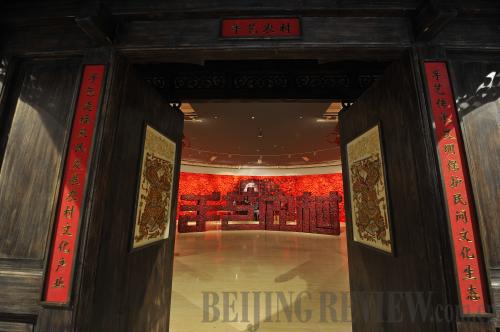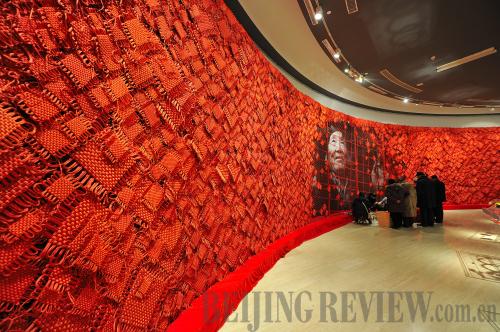|
 |
|
CHINESE STYLE: A typical wooden gate in north China is displayed at the entrance of the Handicrafts in the Countryside exhibition (SHI GANG) |
For more photos and video clip please click here
Against the backdrop of a huge painting of willow trees at the National Art Museum of China in downtown Beijing, Wang Fujing, 40, wove willow twigs into a flower basket as if he were at home. The only difference was he had to stop to explain his weaving technique when visitors asked questions.
Wang was among 11 handicraftsmen showcasing the creativity and ingenuity of Chinese farmers at an art exhibition named Handicrafts in the Countryside.
 |
|
CHINESE RED: A 40-meter-long and 4-meter-high wall is decorated with 3,600 knotting handicrafts at the National Art Museum of China in Beijing (SHI GANG) |
The exhibition, held on January 9-18, was the culmination of a research project on handicrafts made by farmers in east China's Shandong Province. Works displayed included kites, paintings, carvings, weavings and knotting handicrafts. In addition to the items on display, the exhibition also featured cartoons, introductory videos, research notes and papers as well as opportunities for visitors to create crafts of their own.
Lifelong career
 |
|
EASY JOB: Wang Fujing displays willow weaving techniques (SHI GANG) |
Wang, a farmer from Quanhezi Village, Linyi City, learned how to weave willow twigs when he was 16 years old. Since then, all his spare time has been devoted to weaving. Wang said, "[Making] handicrafts is a lifelong career."
Wang said his favorite thing about weaving is that he can use his skills to make money at home, allowing him to spend more time with his family. Over the past decade, his monthly income from weaving has increased from 500 yuan ($62.50) to 2,000 yuan ($285). Wang is now free to sell his product to the highest bidder.
"I feel honored to be here because I never thought I could come to the capital to show off my handicrafts," Wang said. "I was proud that the exterior of the Spain Pavilion at the 2010 Shanghai World Expo was made from wicker woven in our province. It was a showcase of our handicrafts. We have a saying: 'There is no better job anywhere than sitting at home weaving willow twigs.' I think this is true."
Willow weaving has a long tradition in Wang's hometown, which is rich in willow trees. Woven handicrafts have become a pillar industry for the local economy since the 1980s and many daily items such as baskets and food containers are woven from local willows.
Currently, Linyi has 802 companies in the woven handicraft industry, with 250,000 farmers producing woven goods. Products range from furniture, decorative pieces, to gardening and travel equipment. About 80 percent of production is sold overseas. In 2009 alone, the total value of crafts produced in Linyi was 6 billion yuan ($850 million).
Similar to Linyi's woven products, all the handicrafts shown at the exhibition—kites and Spring Festival paintings from Yangjiabu Village; wood carvings from Caoxian County; cloth weaving from Zhencheng County; knot-tying handicrafts from Honghua Township; and gongbi paintings, a Chinese painting style featured with meticulous brush techniques, from Juye County—have brought about huge economic returns to local people.
| 